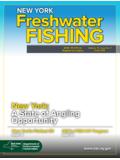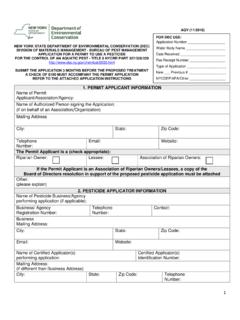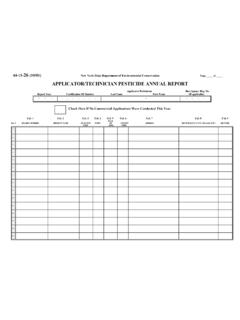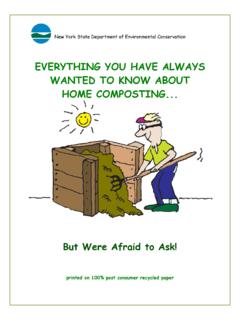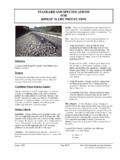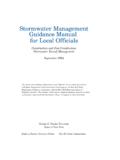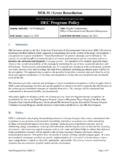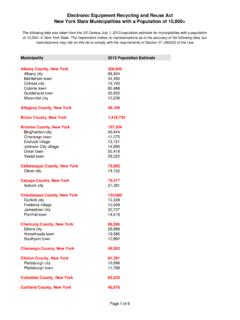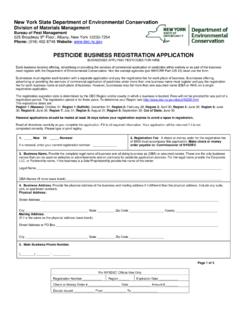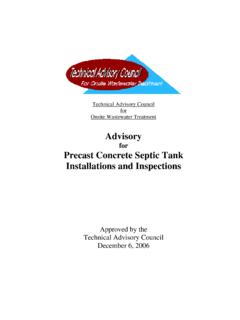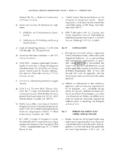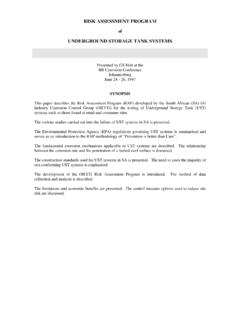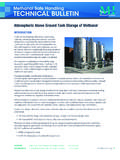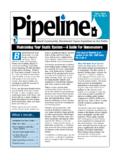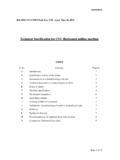Transcription of DEC Program Policy
1 DER-17: Guidelines for Inspecting and Certifying Secondary Containment Systems of Aboveground Petroleum Storage Tanks at Major Oil Storage Facilities New York State Department of Environmental Conservation DEC Program Policy Issuing Authority: Val Washington Title: Deputy Commissioner, Office of Remediation and Materials Management Date Issued: Latest Date Revised: New Policy (Draft). I. Summary: This Program Policy provides guidance on the design and construction of secondary containment systems at major oil storage facilities (MOSF) in New York State. In addition, this document provides guidance on the five year in-depth evaluation of these secondary containment systems. Elements of this guidance document may be used under a consent order at a petroleum bulk storage (PBS) facility.
2 II. Policy : This Program Policy provides guidance on the design and construction of secondary containment systems and the evaluation of those systems. The guidance is intended to assist operators in complying with the associated MOSF license conditions and underlying statutory and regulatory requirements. In addition, the guidance will ensure that compliance reviews of secondary containment systems by Regional MOSF licensing staff are conducted uniformly in each of the New York State Department of Environmental Conservation's (DEC's) nine regions. When completing an inspection of an MOSF secondary containment system, owners must understand the criteria that must be met, how to determine if their systems meet those criteria, and how to properly document the evaluation.
3 The attached guidance addresses each of these issues. Overall, the performance criteria for a secondary containment system are defined in terms of the containment volume, permeability, compatibility, and structural integrity. The guidance explains various procedures for evaluating performance and establishes a uniform approach to documenting the results of the inspection . III. Purpose and Background: A. Purpose: The purpose of this Program Policy is to provide guidance on the design and construction of secondary containment systems and on five year in-depth inspections of secondary containment systems. The design and construction section provides guidance on site investigations, including references to consensus standards. That section also provides guidance on design and construction that is material- specific, including natural/native soil, clay, spray-on liners, synthetic liners, asphalt liners, concrete containment systems, and steel containment systems.
4 DRAFT DER-17 (September 23, 2008) Page 1. The 5- year certification, testing, and inspection section focuses on evaluating the structural integrity, volume, permeability, and compatibility of secondary containment systems. In addition, it provides guidance on material-specific inspections addressing structural integrity, compatibility and permeability. It also provides guidance on the number of samples to be taken, required testing, and the reporting format. In addition, it references industry standards and related test methods that may be used to demonstrate compliance with the secondary containment requirements. As a general principle, the guidance requires a physical test of the secondary containment system whenever visual inspections cannot conclusively confirm the structural integrity of the system.
5 At a minimum, for containment systems with ballast, for every 10,000 square feet of the containment area, 100 square feet of the ballast should be removed and the exposed area visually inspected. B. Background Under section 174 of Article 12 of the Navigation Law (NL), the DEC is responsible for licensing facilities with a total combined storage capacity of 400,000 gallons or more of petroleum. Regulations contained in 17 NYCRR Part 30 and 6 NYCRR Part 610 implement NL section 174. Among other things, Part 30 requires that an applicant for a license or renewal thereof obtain a certification from the DEC that it has implemented or is in the process of implementing New York State and federal plans and requirements for the control, containment, and removal of petroleum discharges.
6 Part 610 sets forth requirements for obtaining such a certification, including compliance with 6 NYCRR Parts 613 and 614. Section (c)(6) of the New York State Petroleum Bulk Storage (PBS) regulations requires tank owners to install secondary containment systems around any aboveground tank which: has a capacity of ten thousand (10,000) gallons or more; or is less than 10,000 gallons, and could reasonably be expected to discharge petroleum to the waters of the State. Separate guidance that explains this subject can be found at (currently SPOTS #17). In addition, section (c)(6) sets forth the following performance standard for secondary containment systems. (i) The secondary containment systems must be constructed so that spills of petroleum and chemical components of petroleum will not permeate, drain, infiltrate or otherwise escape to the ground-waters or surface waters before cleanup occurs.
7 The secondary containment system may consist of a combination of dikes, liners, pads, ponds, impoundments, curbs, ditches, sumps, receiving tanks and other equipment capable of containing the product stored. Construction of diking and the storage capacity of the diked area must be in accordance with the National Fire Protection Association (NFPA) Standard No. 30, section [see subdivision 6 NYCRR (g)]. (ii) If soil is used for the secondary containment system, it must be of such character that any spill onto the soil will be readily recoverable and will result in a minimal amount of soil contamination .. Furthermore, MOSF special license condition Section 3(j) requires that an in-depth secondary containment integrity inspection be performed at least once every five years.
8 Such in-depth inspections DRAFT DER-17 (September 23, 2008) Page 2. must be conducted under the supervision of, and certified by, a New York State licensed and registered Professional Engineer (NYSPE). There are many variables that affect the integrity and performance of a secondary containment system. Therefore the DEC encourages high quality design, construction and maintenance to reduce the difficulty of completing the 5- year in-depth evaluation. IV. Responsibility: The DEC's Regional MOSF licensing staff are responsible for implementing this Policy in consultation with Central Office technical and legal staff. The Bureau of Technical Support of the Division of Environmental Remediation (DER) is responsible for maintaining this Program Policy . V. Procedure: Follow the attached guidance document to inspect and certify secondary containment systems of aboveground petroleum storage tanks at MOSF.
9 VI. Related References: 1. Article 12 of the Navigation Law 2. 6 NYCRR Parts 610, 611, 612, 613, & 614 ( DEC regulations). 3. 17 NYCRR Part 30 & 32 (DOT regulations). 4. 40 CFR Part 112 Spill Prevention, Control and Countermeasures Plans (federal regulations). 5. 40 CFR Part 280 Underground Storage Tanks (federal regulations). 6. 33 CFR Parts 151, 154, 155, 156 (US Coast Guard Operations Manual). 7. Technological Background and Quality Control/quality Assurance for New York State (NYS). Department of Environmental Conservation (DEC) Spill Response Program , March 1991. 8. Analytical Handbook, the New York State Department of Health (NYSDOH). 9. Analytical Services Protocol, the NYS DEC. 10. NYS DEC Division of Environmental Remediation DER-11, Procedures for Licensing Onshore Major Oil Storage Facilities , SPOTS 10 Secondary Containment System Aboveground Storage Tanks and Spots Alternative to Secondary Containment for Small Petroleum ASTs.
10 11. ASTM D 420 Standard Guide to Site Characterization for Engineering, Design, and Construction Purposes . 12. ASTM D 6429 Standard Guide for Selecting Surface Geophysical Methods . 13. ASTM D 6432 Standard Guide for Using the Surface Ground Penetrating Radar Method for Subsurface Investigation . 14. ASTM D 5777 Standard Guide for Using the Seismic Refraction Method for Subsurface Investigation . 15. ASTM D 6820 Standard Guide for Use of the Time Domain Electromagnetic Method for Subsurface Investigation . 16. ASTM D 5434 Standard Guide for Field Logging of Subsurface Explorations of Soil and Rock . 17. ASTM D 422 Standard Test Method for Particle-size Analysis of Soils . DRAFT DER-17 (September 23, 2008) Page 3. 18. ASTM D 2216 Standard Test Methods for Laboratory Determination of Water (Moisture).
